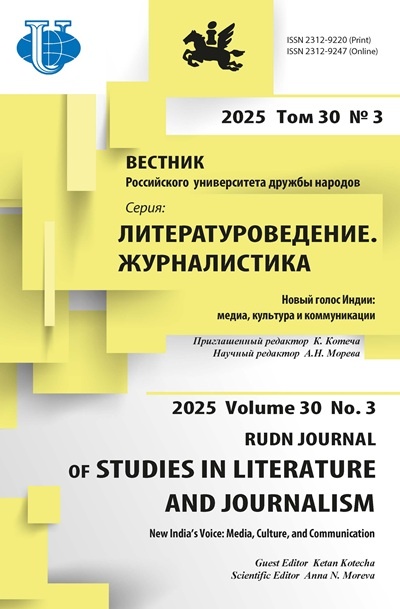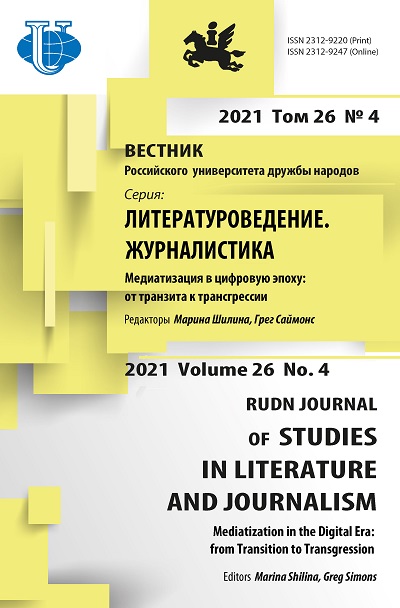Пародийный сказ в «Совах» (советских текстах) Д. Пригова
- Авторы: Романовская О.Е.1
-
Учреждения:
- Астраханский государственный университет
- Выпуск: Том 26, № 4 (2021): МЕДИАТИЗАЦИЯ В ЦИФРОВУЮ ЭПОХУ: ОТ ТРАНЗИТА К ТРАНСГРЕССИИ
- Страницы: 771-780
- Раздел: Литературоведение
- URL: https://journals.rudn.ru/literary-criticism/article/view/29870
- DOI: https://doi.org/10.22363/2312-9220-2021-26-4-771-780
- ID: 29870
Цитировать
Полный текст
Аннотация
Цель статьи - изучить художественные особенности цикла прозаических текстов Д. Пригова «Совы» (советские тексты) как концептуалистского произведения. Автор статьи исследует пародийную стилизацию и обусловленные обращением к ней модификации жанра и стиля. В статье показано, как сказка, былина, предание, анекдот, житие модифицированы содержанием советского мифа, который создает квазиисторию. В «Совах» исторические деятели, политики, поэты и писатели, мифологизированные идеологией и обывательским сознанием, представлены как герои-первопредки и культурные герои; жизненный путь культивируемых советским мифом личностей описан в соответствии с агиографическим каноном. Отправная точка фольклорных стилизаций и пародийных подражаний советскому искусству в цикле «Совы» - маска сказителя-пропагандиста. Пародийный сказ создан путем имитации фольклорного и публицистического стилей, их гибридизации на лексико-грамматическом и ритмико-синтаксическом уровнях. Игра с масками, стилями, жанрами в цикле Д. Пригова «Совы» впервые исследована с методологической позиции нарратологического анализа текста, что подчеркивает новизну и актуальность исследования. Автор статьи приходит к выводу о том, что Д. Пригов деконструирует советские мифологемы, демонстрируя превращение мифа в анекдот, знаменитого имени - в пустой знак, истории - в симулякр.
Ключевые слова
Об авторах
Ольга Евгеньевна Романовская
Астраханский государственный университет
Автор, ответственный за переписку.
Email: rom.vs.olga@gmail.com
ORCID iD: 0000-0002-7700-5163
кандидат филологических наук, доцент кафедры литературы
Российская Федерация, 414056, Астрахань, ул. Татищева, 21аСписок литературы
- Кобринский А.А. Даниил Хармс. М.: Молодая гвардия, 2009. 508 с.
- Кожевникова Н.А. Типы повествования в русской литературе ХIХ-ХХ веков. М.: ИРЯ, 1994. 332 с.
- Курганов Е.Я. Анекдот как жанр русской словесности. М.: Arsis Books, 2014. 264 с.
- Липовецкий М.Н. Паралогии: Трансформации (пост)модернистского дискурса в русской культуре 1920-2000-х годов. М.: Новое литературное обозрение, 2008. 848 с.
- Лойтер С.М. Былина-панегирик, плач-панегирик, сказка-панегирик // Труды Карельского научного центра РАН. 2010. № 4. С. 154-157.
- Мелетинский Е.М. Поэтика мифа. М.: Академический проект; Мир, 2012. 331 с.
- Пригов Д.А. Москва. Собрание сочинений: в 5 т. М.: Новое литературное обозрение, 2016. 952 с.
- Хеллман Б. «Великий друг детей». Образ Сталина в советской детской литературе // История и повествование: сборник статей. М.: Новое литературное обозрение, 2006. С. 446-460.
- Цвигун Т.В. Однажды в нарративах Д. Хармса // Вестник Балтийского федерального университета им. И. Канта. 2014. Вып. 8. С. 44-48.
- Шмелева Е.Я., Шмелев А.Д. Русский анекдот: Текст и речевой жанр. М.: Языки славянской культуры, 2002. 144 с.
- Эйдельман О.В. Легенды и мифы Советского Союза // Логос. 1999. № 5 (15). С. 52-65.
Дополнительные файлы















